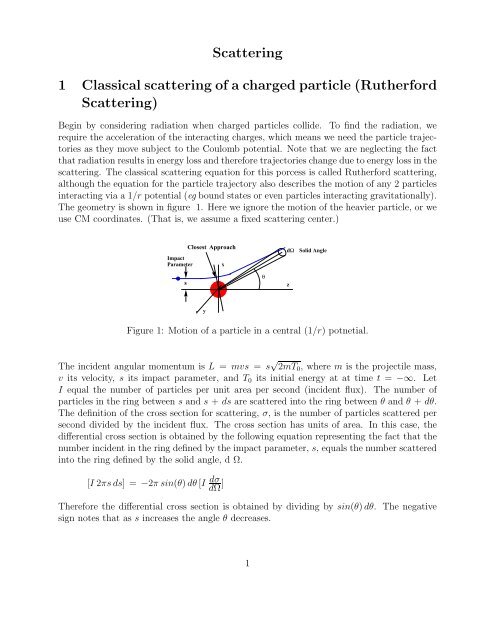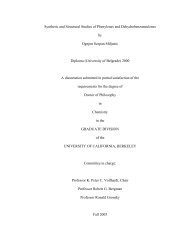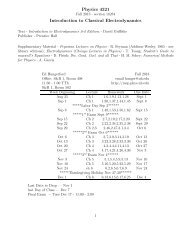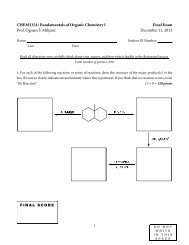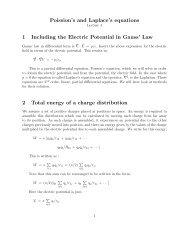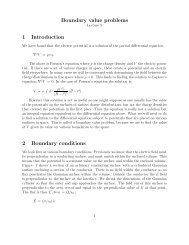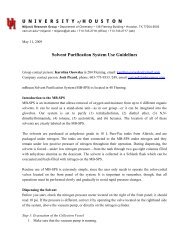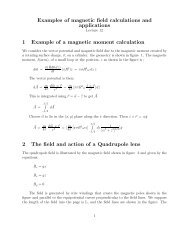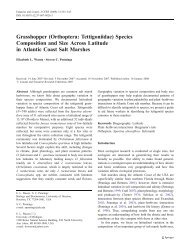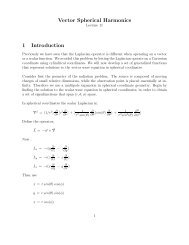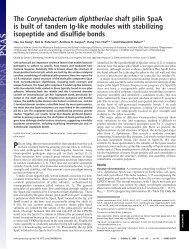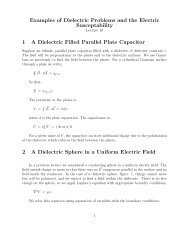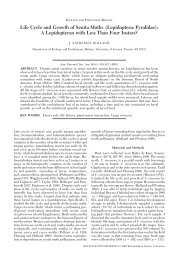Scattering 1 Classical scattering of a charged particle (Rutherford ...
Scattering 1 Classical scattering of a charged particle (Rutherford ...
Scattering 1 Classical scattering of a charged particle (Rutherford ...
You also want an ePaper? Increase the reach of your titles
YUMPU automatically turns print PDFs into web optimized ePapers that Google loves.
<strong>Scattering</strong>1 <strong>Classical</strong> <strong>scattering</strong> <strong>of</strong> a <strong>charged</strong> <strong>particle</strong> (<strong>Rutherford</strong><strong>Scattering</strong>)Begin by considering radiation when <strong>charged</strong> <strong>particle</strong>s collide. To find the radiation, werequire the acceleration <strong>of</strong> the interacting charges, which means we need the <strong>particle</strong> trajectoriesas they move subject to the Coulomb potential. Note that we are neglecting the factthat radiation results in energy loss and therefore trajectories change due to energy loss in the<strong>scattering</strong>. The classical <strong>scattering</strong> equation for this porcess is called <strong>Rutherford</strong> <strong>scattering</strong>,although the equation for the <strong>particle</strong> trajectory also describes the motion <strong>of</strong> any 2 <strong>particle</strong>sinteracting via a 1/r potential (eg bound states or even <strong>particle</strong>s interacting gravitationally).The geometry is shown in figure 1. Here we ignore the motion <strong>of</strong> the heavier <strong>particle</strong>, or weuse CM coordinates. (That is, we assume a fixed <strong>scattering</strong> center.)ImpactParameterClosest ApproachxdΩSolid AnglesθzyFigure 1: Motion <strong>of</strong> a <strong>particle</strong> in a central (1/r) potnetial.The incident angular momentum is L = mvs = s √ 2mT 0 , where m is the projectile mass,v its velocity, s its impact parameter, and T 0 its initial energy at at time t = −∞. LetI equal the number <strong>of</strong> <strong>particle</strong>s per unit area per second (incident flux). The number <strong>of</strong><strong>particle</strong>s in the ring between s and s + ds are scattered into the ring between θ and θ + dθ.The definition <strong>of</strong> the cross section for <strong>scattering</strong>, σ, is the number <strong>of</strong> <strong>particle</strong>s scattered persecond divided by the incident flux. The cross section has units <strong>of</strong> area. In this case, thedifferential cross section is obtained by the following equation representing the fact that thenumber incident in the ring defined by the impact parameter, s, equals the number scatteredinto the ring defined by the solid angle, d Ω.[I 2πs ds] = −2π sin(θ) dθ [I dσdΩ ]Therefore the differential cross section is obtained by dividing by sin(θ) dθ. The negativesign notes that as s increases the angle θ decreases.1
dσdΩ = − sin(θ) sdθdsAssuming a completely elastic collision, energy is conserved during the motion <strong>of</strong> the charge.Thus in spherical coordinates, the conservation <strong>of</strong> energy is given by;(1/2)mṙ 2 + (1/2) L2mr 2 + U = constant = T 0The angular momentum, l for a central force (Coulomb) is also conserved. This is;l = mr 2 ωThis allows an exchange <strong>of</strong> the variable <strong>of</strong> integration from t to θ.dθ ′ =l drmr 2√ (2/m)[t 0 − U r − l 2 /(2mr 2 )]This is integrated after using the Coulomb potential, U =4πǫ 1 zZe2 r . Here z and Z are thecharge on the <strong>particle</strong> and <strong>scattering</strong> center, respectively, and e the electronic charge. Thesolution is;(1/r) = − mqQL 2 (1 + η cos(θ) ′ )This is the equation <strong>of</strong> a hyperbola or an ellipse depending on the sign <strong>of</strong> the energy. Theexcentricity, η, is√η = 1 + 8πǫE 0L 2mzZ(e) 2Now Change the angle θ ′ to the <strong>scattering</strong> angle θ as observed in Figure 2, where θ = π−2θ ′ .This results in the equation;cot(θ/2) = 8πǫT 0szZe 2s = zZe28πǫT 0cot(θ/2)Substitution into the equation for the cross section gives;dσdΩ = [ zZe24πǫT 0] 2 [ 1sin 4 (θ/2) ]In reality the <strong>scattering</strong> is not elastic as the charge is accelerated and loses energy. Thisloss could be determined by a perturbation series as it is small. However, to first order thetrajectory does not change so the velocity and acceleration <strong>of</strong> the charge q can be foundusing the acceleration as determined from the equation <strong>of</strong> motion to get the radiated power.2
sClosestApproachθxθθFigure 2: The geometry to convert the angle used to solve the equation <strong>of</strong> motion to the<strong>scattering</strong> angle2 Solution to the <strong>scattering</strong> equationIn the above section we considered <strong>scattering</strong> <strong>of</strong> a <strong>particle</strong> from another <strong>particle</strong> when theinteraction between them was the Coulomb force (represented as will be seen later, bythe exchange <strong>of</strong> a virtual photon). In this section we develop a general description <strong>of</strong> the<strong>scattering</strong> <strong>of</strong> a classical, real photon from a charge.This <strong>scattering</strong> can be considered as a solution to the wave equation. Although we will usethe scalar wave equation, recognize that a vector such as an EM field can be considered asa set <strong>of</strong> scalar components. The wave equation has the form;[∇ 2 − (1/c 2 ) ∂2∂t 2 ]ψ = S(⃗r, t)In the above, ψ is the wave amplitude and S the <strong>scattering</strong> center, or in this case the source<strong>of</strong> the scattered wave. In the case <strong>of</strong> EM <strong>scattering</strong>, the source <strong>of</strong> the scattered wave dependson the strength <strong>of</strong> the incident wave so we rewrite this term as S → Sψ. In the <strong>scattering</strong>region (ie as r → ∞) the solution, ψ, consists <strong>of</strong> an incident wave plus an outgoing sphericalwave. <strong>Scattering</strong> assumes that the the source term is localized so that sufficiently far awaythis term → 0 and waves in this region are solutions to the homogeneous wave equation.Now we also assume that the source ands solution are harmonic in time, ψ(⃗r, t) → ψ(⃗r)e iωtwhich removes the time dependence <strong>of</strong> the equation. The full wave equation is then;[∇ 2 − k 2 ]ψ = S(⃗r)ψThe incident wave has the form <strong>of</strong> a plane wave solution;3
ψ in = e ikz = e ikr cos(θ) .The scattered wave has the form <strong>of</strong> an outgoing spherical wave;ψ out → f(θ, φ) eikrrThen the asymptotic form <strong>of</strong> the solution as r → ∞ <strong>of</strong> the <strong>scattering</strong> equation isψ = ψ in + ψ outwith R = |⃗r −⃗r ′ | and L operating on the wave amplitude, ψ, which equals the source. Thenif we formally define an operator L −1 . The solution we seek has the form at a time t → ∞;ψ = ψ in + ψ outwhere ψ in is the form <strong>of</strong> the incoming wave and ψ out is the outgoing spherical wave. Thewave equation can be written in operator form as;ψ out = L −1 Sψ.Formally we can then write;ψ out =11 − (L −1 S) L−1 (Sψ in )Then substitute for ψ = ψ in + ψ out and collect terms. The formally solution is then writtenas;ψ out = [1 + L −1 S + L −1 SL −1 S + · · ·] ψ inThe series converges if the source term is sufficiently small. Generaly the scattered EM waveis much less than the incident wave so we take the first term, called the Born term, as theapproximate solution. The differential <strong>scattering</strong> cross section is then defined by the scatteredpower into a solid angle dω divided by the incident flux. The incident flux is obtainedfrom the Poynting vector <strong>of</strong> the incident plane wave.S in = |E| 2 /µcThus the cross section in the Born approximation can be written;dσdΩ=(1/cµ)|f(θ, φ)|2(1/cµ)|e ikz | 2 = |f(θ, φ)| 2 4
Now a properly normalized outgoing Green’s function for a point source can be written ase ikRR(ie the Green function in a previous lecture). Therefore the solution in practical ratherthan in the above formal formal terms can be written ;ψ out = ∫ d⃗r eikRR S(⃗r′ )ψ in + ∫ d⃗r eikRR S(⃗r′ )ψ outThis is not a solution but an integral equation because ψ is not known until the solution isobtained, ie the source term in the intergand is unknown.3 <strong>Scattering</strong> <strong>of</strong> the EM wave<strong>Scattering</strong> generally occurs when the EM wavelength is large compared to the <strong>scattering</strong>source. EM <strong>Scattering</strong> occurs when some <strong>of</strong> the incident wave is absorbed and re-radiated.As in radiation, we keep the lowest terms in the multipole expansion <strong>of</strong> the scattered fields.Almost always this results in dipole radiation as the incident wave polarizes the charges inthe <strong>scattering</strong> center. If the incident wave has large amplitude, then it is possible that thecharges will not move linearly with the incident E field, but will bend due to the ⃗v × ⃗ B force<strong>of</strong> the magnetic component in the incident wave. An intense incident wave would probablyalso require terms <strong>of</strong> higher order than the Born term in the perturbation expansion forthe cross section. The <strong>scattering</strong> formulation occurs as follows (we always assume a timedependence <strong>of</strong> e iωt )A plane, monochromatic, linearly polarized wave is incident on a <strong>scattering</strong> center. Theincident wave is polarized in the ˆx direction and moves in the ẑ direction.;⃗E in = ˆxE 0 e ik inrcos(θ)⃗B in = ˆk in /c × ⃗ E inThese fields induce dipole moments (⃗p, ⃗m) in the <strong>scattering</strong> center. The dipoles radiate energy.This radiation can be calculated in the multipole approximation which uses the staticfields obtained from the multipole moments. The dipole fields are;⃗E sc =4πǫ k2 eikrr [ˆn × ⃗p × ˆn] − z 0k 24π eikrr [ˆn × ⃗m]⃗B sc = (1/c)ˆn × ⃗ E scIn the above, ⃗p and ⃗m are the induced electric and magnetic dipole moments.5
zθn^^k ina^xx^φa^yFigure 3: The geometry used to obtain the polarization vectors for <strong>scattering</strong> from a dielectricsphere4 Dipole cross section for a dielectric sphereUsing the Poynting vector and the dipole fields obtained previously. We find the differentialradiated power for dipole.dσdΩ = r2 |â · ⃗E sc | 2ẑ · | E ⃗ in | 2The unit vector â defines directions perpendicular to the observation direction ˆn. Substitutionfor the field givesdσdΩ =k4(4πǫ) 2 |â · ⃗p + (1/c)(ˆn × â) · ⃗m| 2For a small dielectric sphere <strong>of</strong> radius, η, the electric dipole moment <strong>of</strong> the sphere is;⃗p = 4πǫ 0 ( ǫ − 1ǫ + 2 )η3 ⃗ EinUse the geometry shown in Figure. 3. The cross section is obtained for the scattered polarizationperpendicular â ⊥ and parallel, â ‖ to the <strong>scattering</strong> plane as defined by the planecontaining the incident and <strong>scattering</strong> vector directions. From the figure;â ‖ · ˆx = cos(θ) cos(φ)â ⊥ · ˆx = −sin(φ)Averaging over all possible initial polarizations (ie averaging over φ) we obtaindσ ‖dΩ = k4 η 62 |ǫ − 1ǫ + 2 |2 cos 2 (θ)6
dσ ⊥dΩ = k4 η 62 |ǫ − 1ǫ + 2 |2The total differential cross section is;dσdΩ = dσ ‖dΩ + dσ ⊥dΩThe total cross section is obtained by integration over dΩ.σ T = 8πk4 η 63| ǫ − 1ǫ + 2 |2The polarization <strong>of</strong> the scattered wave is;P(θ) = dσ ⊥/dΩ − dσ ‖ /dΩdσ ⊥ /dΩ + dσ ‖ /dΩ =sin2 (θ)1 + cos 2 (θ)5 Form factorSuppose the scatterers are a system <strong>of</strong> charges with fixed locations in space. The resultis a superposition <strong>of</strong> <strong>scattering</strong> amplitudes from all the point <strong>scattering</strong> centers. We havepreviously seen that coherence must be included when one adds the contributions from each<strong>scattering</strong> point. Assume that the positions <strong>of</strong> the scatters are located by the vectors, ⃗x j .The incident wave will have the phase factor, e ik 0ˆn 0·⃗x j, and the phase for the scattered waveat large distances will be e ikˆn·⃗x j. Here ˆn 0 is the direction <strong>of</strong> the scattered wave. We assumedipole <strong>scattering</strong> and write;dσdΩ =k4(4πǫ) 2 | ∑ j[â · ⃗p j + (1/c)(ˆn × â) · ⃗m j ] e i⃗q·⃗x j| 2In the above write ⃗q = kˆn 0 − kˆn = k(ˆn 0 − ˆn) for elastic <strong>scattering</strong> from massive points,(ie no recoil). Then suppose that the scatterers are identical so that ⃗p j = ⃗p and ⃗m j = ⃗m.Rewrite the above as;where;dσdΩ = [dσ sdΩ ] F(q)dσ sdΩ =F(q) = | ∑ jk4(4πǫ) 2 [â · ⃗p j + (1/c)(ˆn × â) · ⃗m j ] 2e i⃗q·⃗x j| 2 = ∑ jne i⃗q·(⃗x j−⃗x n)7
For a random distribution <strong>of</strong> a large number <strong>of</strong> <strong>scattering</strong> centers the phase difference betweenthe points causes the structure factor,F(q), to average to zero unless j = n. Whenj = n, the sum results in F(q) = N, the number <strong>of</strong> <strong>scattering</strong> centers. On the other handif the <strong>scattering</strong> centers are distributed in an ordered array then F(q) is small unless ⃗q ≈ 0.This is coherent <strong>scattering</strong>. Thus consider the form in 1-D;∑e i⃗q·(⃗x j−⃗x n) → ∑ e iqx je iqxnjnjnNow let x j = jd where d is the spacing <strong>of</strong> the centers. The sum is converted to an integral by;1 = [(j + 1) − j] = (δj) = [x j+1 − x j ]/d = ∆x/d∞∑j=−∞e iqx k =∑ (δj)eiqx k = (1/d)∞∫−∞dxe iqx k=δ(q)2πdFinally suppose the centers are distributed by some function f(⃗r) so that ⃗pf(⃗r) representsthe electric dipole moment per unit volume (use the electric moment here but it is obvioushow to include the magnetic moment). The <strong>scattering</strong> due to this distribution is ;dσdΩ =k4(4πǫ) 2 | ∫ d 3 x ′ (â · ⃗p) f(⃗r ′ ) e i⃗q·⃗x′ | 2which we re-write as previously;anddσ sdΩ =k4(4πǫ) 2 |[â · ⃗p] 2F(q) = | ∫ d 3 x ′ f(⃗r ′ )e i⃗q·⃗x′ | 2dσdΩ = dσ sdΩ F(q)The structure function (form factor) is the Fourier transform <strong>of</strong> the spatial distribution <strong>of</strong>the <strong>scattering</strong> centers.6 Expansion <strong>of</strong> a plane wave in spherical harmonicsThe <strong>scattering</strong> problem is solved naturally in spherical coordinates, as the center <strong>of</strong> the coordiantesystem is chosen to lie at the center <strong>of</strong> the scatttering source. Also the <strong>scattering</strong>solution is to be obtained in a multipole series as the <strong>scattering</strong> amplitude is observed as thedistance from the <strong>scattering</strong> center → ∞. However, a plane wave incident on the <strong>scattering</strong>center is formulated in Cartesian coordinates. Thus we must formulate the incident wave in8
a spherical system, written in terms <strong>of</strong> spherical harmonics. We write;e ikz = e ikr cos(θ) = ∑ C n Y 0 nUse the orthonormal properties <strong>of</strong> the spherical harmonic to write;C n = 2π ∫ d(cos(θ)) Y 0 neikrcos(θ)Note that an integral representation <strong>of</strong> the spherical Bessel function, j l (kr), isj l (kr) = (−i) l /2π∫0d(cos(θ)) e ikr cos(θ) P n (cos(θ)We may also use the addition theorem which has the form;P l (cos(θ)) =4π2l + 1∑mYlm (θ 1 , φ 1 ) Yl ∗ m (θ 2 , φ 2 )where the angles (1) and (2) refer to the angles <strong>of</strong> vectors ⃗ k and ⃗r in the specified coordinatesystem. This gives the required form for the plane wave;e ikr cos(θ) = 4π ∑ i l j l (kr) Yl m (ˆk) Yl∗ m (ˆr)l,mThis form for the incident wave can then be matched at the <strong>scattering</strong> surface to the fieldequations inside and outside the <strong>scattering</strong> center by matching the boundary conditions atthe surface. Recall that a similar technique was used to obtain the reflection (<strong>scattering</strong>)and transmission coefficients <strong>of</strong> an EM wave incident on a dielectric and conducting surfaceplaner surfaces. For example, this technique can be used to develop Mie <strong>scattering</strong> (light<strong>scattering</strong> from small dielectric <strong>particle</strong>s).7 Thompson <strong>scattering</strong> (e.g.<strong>Classical</strong> EM <strong>scattering</strong> fromatomic electrons)The power radiated by an accelerated charge is obtained from the Poynting vector.⃗S = ⃗ E × ⃗ H = ǫc|E| 2 ˆnThe radiation field <strong>of</strong> an accelerated charge when β ≪ c is ;⃗E =4πǫ q × ˆn ×⃗˙β[ˆnR] ret9
Thus the radiated power into solid angle dΩ is ;dPdΩ=q216π 2 ǫc [ˆn × ˆn × ⃗˙β] 2If a <strong>charged</strong> <strong>particle</strong> is accelerated by the ⃗ E field <strong>of</strong> an EM wave we have;⃗E I = E 0I e i(⃗ k·⃗r − ωt) ⃗η 0⃗F(force) = m⃗a = mc ⃗˙β = q ⃗ EI⃗˙β = (q/mc)E 0I e i(⃗ k·⃗r−ωt) ˆη 0Ignore phase differences (take the instantaneous time) and let (ˆη be the polarization direction,Figure 4.〈 dPdΩ 〉 = c ǫ ( q 24πmc 2 ) 2 |ˆη · ˆη 0 | 2The incident flux is the time-averaged Poynting vector <strong>of</strong> the incident wave so the crosssection is;dσdΩ = 〈(dP/dΩ)〉〈S in 〉dσdΩ = ( q 24πǫmc 2 ) 2 |ˆη · ˆη 0 | 2The evaluation <strong>of</strong> the factor |ˆη · ˆη 0 | 2 is obtained from Figure 4.ˆη 1 = cos(θ)[ˆxcos(φ) + ŷ sin(φ)] − ẑ sin(θ)ˆη 2 = −ˆx sin(φ) + ŷ cos(φ)Choose ˆη 0 = ˆx and sum over the final polarizations to obtain;|ˆη · ˆη 0 | 2 = cos 2 (θ) cos 2 (φ) + sin 2 (φ)This result can be substiuted above to obtain the scattered differential power. Note we haveneglected the effect <strong>of</strong> the magnetic field on the motion <strong>of</strong> the accelerated charge, but thiseffect was worked out to first order in an earlier example.10
IncidentDirectionzθn^ScatteredDirection^η 0xφθη^η^φ 21yFigure 4: The geometry used to evaluate the angles in Thompson <strong>scattering</strong>8 BremsstrahlungThe general form <strong>of</strong> the radiated energy,dWdΩ= ∫ dt dPdΩ ;Thus use ⃗ S = ǫc|E| 2ˆn and ⃗ E =dWdΩ= A ∫ dt |E| 2 R 24πǫ q × ˆn ×⃗˙β[ˆnR] Ret and write;In the above A is a constant depending on the charge. Take the Fourier transform <strong>of</strong> thefield using the time dependence <strong>of</strong> the field, e iωt .E(ω) = 1 √2π∫dt E(t) eiωtE(t) = 1 √2π∫dω E(ω) e−iωtThen substitute to obtain;dWdΩ= (AR 2 /2π) ∫ dt ∫ dω ∫ dω ′ E ∗ (ω ′ ) E(ω) e i(ω−ω′ )tdWdΩ= (AR 2 /2π) ∫ dω |E(ω)| 2Therefore we identify the frequency spectrum <strong>of</strong> the radiation where I is the intensity(power/area) as;d 2 IdωdΩ = 2A|E(ω)|2 R 2Now substitute for the radiation field <strong>of</strong> an accelerated <strong>particle</strong> (use the relativistically correctexpression);11
d 2 IdωdΩ = [ q 2 ∞∫16π 3 cǫ ]|−∞dt [ˆn × [(ˆn − ⃗ β) × ˙⃗ β](1 − ⃗ β · ˆn) 2 e iω[t−⃗ β·R/c] | 2For low frequencies, the exponential term is ≈ 1. Note that;ˆn × (ˆn − ⃗ β) × ˙⃗ β1 − ⃗ β · ˆn= d dtIntegrate by parts to obtain;d 2 IdωdΩ = [ q 2 ∞∫16π 3 cǫ ]|−∞d] [ˆn × ˆn × β ⃗1 − β ⃗ · ˆn[ˆn × ˆn × ⃗ β1 − ⃗ β · ˆnAlso assume non-relativistic motion, β → 0.d 2 IdωdΩ = [ q 216π 3 cǫ ]|ˆη · ∆⃗ β| 2]In the above ˆη is the polarization direction, and ∆ ⃗ β is the differential change in the velocity<strong>of</strong> the charge. In the s<strong>of</strong>t photon limit, the energy <strong>of</strong> a photon is ω so the number <strong>of</strong> photonsinto dΩ and between frequencies between ω and ω + dω is approximately;q 2N ph = (1/ω)[16π 3 cǫ ]|ˆη · ∆⃗ β| 2The cross section for s<strong>of</strong>t photon emission in a <strong>charged</strong> <strong>particle</strong> collision is;d 3 σ = [N dσdΩ q d(ω)dΩ ph ]gam dΩ qWhere dσdΩ qis the cross section for a Coulomb interaction (<strong>Rutherford</strong> <strong>scattering</strong>). Thensubstitute the various equations and integrate. Use figure 5 to obtain ∆ ⃗ β. The result forlow frequencies and non-relativistic motion is;dIdω =q24π 2 cv [ln(1.123γv wb min)]MvMvθQ = |Pin − Pout| < 2Mv∆ P ~ QFigure 5: The geometry for the momentum transfer12
q/2vvq/2φ oFigure 6: Radiation from sets <strong>of</strong> charge rotating in a circle∆ρ ∆p ≈ with ∆ρ = bb min (cut <strong>of</strong>f value due to screening) = /2Mv = /Q max9 Radiation and coherenceWe have seen that an accelerated charge radiates energy. Suppose we set 2 charges in symmetricpositions on a loop and let them spin around the z axis as shown in figure 6. Thisresults in radiation because the charges are accelerated. Now suppose we consider the loopfilled with a continuium charge distribution that rotates. Contrary to intuition, there isno radiation. This occurs because <strong>of</strong> coherence <strong>of</strong> the radiation from each <strong>of</strong> the elementalcharge distributions cancels the radiation field. We see this as follows. The charge distribution<strong>of</strong> the two elements as shown in the figure can be written;δ(r − a)ρ = (q/2)a 2 δ(θ − π/2)[δ(φ + φ 0 ) + δ(φ − φ 0 )]We rewrite the charge per unit length so that we can add additional symmetric units <strong>of</strong>charge;λ =q(n + 1) πa δ(φ − πk/N − φ 0) k = 0, 1, 2, · · · , N − 1All <strong>of</strong> the charge elements rotate with the frequence ω. The charge density is then written;ρ k =q δ(r − a)(n + 1)π a 2 δ(θ − π/2) δ(φ − πk/N − ωt)13
Now work out the Fourier components <strong>of</strong> the distribution.ρ k = ∑ A n cos(n[φ − ωt])The coefficients A n are found using othorgonality <strong>of</strong> the Fourier functions, so that;Then;ρ k =q δ(r − a)(n + 1)2π a 2 δ(θ − π/2) ∑ ncos(2πkn/N) cos(n[φ − ωt])ρ = N−1 ∑k=0ρ kThe sum over k provides the followingN−1 ∑k=0cos(2πnk/N) = cos(nπ[1 − 1/N])sin(nπ)sin(nπ/N)This is zero unless n = N or 0. Thus the radiation has multipolarity N. But if N → ∞there will be no radiation. In effect the radiation from each charge elecment contributescoherently, cancelling the radiated power.10 Index <strong>of</strong> refractionWe choose to look at a simple model that will demonstrate that the index <strong>of</strong> refraction isdue to an interference between the incident wave and the scattered wave represented byradiation from absorption <strong>of</strong> the incident wave on atomic electrons. Look at fig 7. Theatomic electrons in a ring <strong>of</strong> radius ρ in the (x, y) plane are caused to harmonically oscillatedue to a plane wave incident along the z axis. We assume the electric vector <strong>of</strong> this wave ispolarized in the x direction.The electrons are bound to atoms, we assume by a linear force, resulting in the non-relativisticharmonic force equation;m d2 xdt 2 + kx = qE e iωtThe 1 2t term is the intertial force, ma, the 2 nd term is the restoring force keeping the electronbound to the nucleus, and the 3 rd term is the driving force due to the EM field.The solution is ;x = x 0 e iωt = qE/mω 2 0 − ω 2 e iωt 14
xEρyrPzFigure 7: A schematic <strong>of</strong> a model for an incident plane wave scattered from a ring <strong>of</strong> atomicelectrons in the x, y) planeThe time derivatives give the velocity and acceleration which are placed in the non-relativisticexpression for the radiation field.E = (e/4πǫ)[ˆn × ˆn × ˙⃗ β] e iωt /rNow multiply by the number <strong>of</strong> electrons per unit area in the plane, N, and integrate overthe surface <strong>of</strong> the plane 2π ∫ ρ dρ. Change the variable to an integration over the distancefrom the electron to the observation point on the z axis, r 2 = ρ 2 + z 2 and approximate thevalue <strong>of</strong> t ′ as t ′ ≈ t − r/c. This results in the expression;E total = qN4πǫcE total = 2πqNω2 x 04πǫcE total ≈ 2πiqNωx 04πǫc∫ρ dρ∫dφ ω 2 x 0 e i(ωt−R/c)e iωt ∞ ∫ze iω(t−r/c)rdr e −iωr/c /rTo this result we add the incident wave e iω(t−z/c) . Now we can write the wave at the pointz as due to a wave having the form,E = E 0 e iω(t−(n−1)∆z/c−z/c)The incident wave propagation from the plane is just e iω(t−z/c) the additional term (n−1)∆z/cis the time delay experienced by the wave when passing through the dielectric material havingindex n and thichmess, ∆z. For small values <strong>of</strong> ∆z expand this term to write the fieldat the observation point as;15
E ≈ E 0 e iω(t−z/c) iω(n − 1)∆z[1 − c ]Divide through by the thickness ∆z and identify this result with the previous calculation <strong>of</strong>the scattered field;(n − 1) = 2πq2 (N/∆z)4πǫm(ω 2 0 − ω2 )The term N/∆z is the Number density <strong>of</strong> the electrons.11 Cherenkov RadiationCherenkov radiation occurs when a <strong>charged</strong> <strong>particle</strong> is moving faster that EM radiation travelsin that medium. Observe figure 8. The present point lies a further distance from theretarded point than the observation point. That is V (t − t ′ ) > (c/n)(t − t ′ ). Here, n is theindex <strong>of</strong> refraction <strong>of</strong> the medium. A wave front can be drawn as a line that lies from thetangent to the spherical wave front to the present point as shown in fig. 8. Each sphericalwave front from a point along the <strong>particle</strong> trajectory will be tangent to this line. The angle<strong>of</strong> propagation <strong>of</strong> the wave front θ is obtained from the figure as;(c/n)tθFigure 8: The geometry <strong>of</strong> wave fronts in Chernekov radiationvtcos(θ) = ct/nvt= 1nβPreviously we chose the retarded point <strong>of</strong> the Lienard-Eiechert potentials because <strong>of</strong> causality.In Cherenkov radiation both retarded and advanced points are possible solutions as onecan see in fig. 9 The positions <strong>of</strong> the observation and present points are related by (we usec here but note that it is really c/n);c(t − t ′ ) = | ⃗ X + ⃗ V (t − t ′ )| = R/c16
RetardedPointn^R =c(t − t’)θβObservationPointR XAdvancedPointV(t − t’)αPresentPointFigure 9: The geometry <strong>of</strong> Chernekov radiation showing the retarded, advanced, and observationpointsThis equation is written for ∆t = (t − t ′ ) ;c 2 ∆t 2 = X 2 + V 2 ∆t 2 + 2 ⃗ X · ⃗V ∆t.This is a quadratic equation with solutions;√∆t = − X ⃗ · ⃗V ± ( X ⃗ · ⃗V ) 2 − (V 2 − c 2 )X 2(V 2 − c 2 )We have that ∆t > 0 so that there is only one real positive root for V < c which correspondsto the retarded point. For V > C there is no real root for ⃗ X · ⃗V > 0 but when ⃗ X · ⃗V < 0there are 2 solutions. This occurs for values <strong>of</strong> α > π/2 . From the discriminate;cos(α) = −[1 − (c/v) 2 ] 1/2These solutions are the advanced and retarded points, so the Lienard-Wiechart potentialscan be simply multiplied by 2 to include the advanced point as both retarded and advancedpoints are a distance X away from the observation point.Now we look more carefully at this solution which represents a shock front singularity. Thegeneral form <strong>of</strong> the angular distribution <strong>of</strong> the radiated power is written;dPdΩ= (1/2µc)Re| ⃗ E ∗ · ⃗E|R 2We develop the Fourier spectrum <strong>of</strong> the E field, by;17
E = √ 1 ∞∫2π−∞E(t) = √ 1 ∞∫2πdt e iωt E(t)−∞dt e −iωt EThe energy radiated is the time integral <strong>of</strong> the power. Therefore;dWdΩ= 12πµc∞∫−∞dt∞∫−∞dω∞∫−∞dω ′ ⃗ E∗ · ⃗E e i(ω′ −ω)tInterchange the time and frequency integration and differentiate with respect to ω.dWdΩ= 12µc |E(ω)|2 R 2The above is the energy radiated per unit solid angle. The equation has been multiplied bythe differential area element, R 2 dΩ and a factor <strong>of</strong> (1/2) is included so that we define ω > 0always. The radiation field (Gaussian units) is;E(t) = (q/c)[ ˆN × (ˆn − β) ⃗ × ˙⃗ βκ 3 ] = (e/cκ) d Rdt [ˆn × (ˆn × β)] ⃗The right side <strong>of</strong> the energy equation has the form G ∗ G.G = 1(4µc) 1/2 E(ω)R = 1(8πµc) 1/2∞∫−∞dt e iωt [ˆn × (ˆn − ⃗ β) × ˙⃗ βκ 3 ]Change to present time units, κt, and approximate the time in the phase component byt ′ ≈ t − ˆn · ⃗r/c for large r. Integrate by parts over the time, and then put this value for Gback into the equation for the differential power above to obtain;d 2 Idω dΩ = q2 ω 216π 2 c 3 |∞∫−∞dt[ˆn × (ˆn × ⃗ β)] e iω(t−ˆn·⃗r/c) | 2In a dielectric medium the velocity <strong>of</strong> the EM wave is c → c/n = c/ √ ǫ with n the index <strong>of</strong>refraction. Assume straight line motion so that ⃗r = ⃗ V t .d 2 Idω dΩ = µq2 cω 216π 2 |ˆn × V ⃗ ∞∫(ω 2 /2π) dt e iωt(1−ˆn·⃗r/nc) | 2−∞The integral is a δ function and results in the expression for the intensity <strong>of</strong> the Cherenkovradiation (Gaussian units);d 2 Idω dΩ = q2 β 2nc sin2 (θ)|δ(1 − (β/n) cos(θ)| 2The above δ function gives the Cherenkov angle as previously obtained. As an example,glass has an index <strong>of</strong> refraction <strong>of</strong> 1.5. The Cherenkov angle is then;18
cos(θ) = 1/(1.5β)and gives a cut-<strong>of</strong>f velocity <strong>of</strong> β = 0.666 An electron with this velocity has a momentum <strong>of</strong>0.45 MeV.12 Synchrotron radiationSynchrotron radiation occurs when a <strong>particle</strong> is acclerated perpendicular to the velocity asin a circular orbit. It occurs naturally for electrons moving around the magentic field lines inthe upper atmosphere <strong>of</strong> the earth, and in electron accelerators used to produce EM radiationfor studies <strong>of</strong> material strucutre and biological samples. Suppose a relativistic <strong>particle</strong> in acircular orbit as shown in figure 10. The radius <strong>of</strong> the orbit is ρ, and we assume a pulsedbeam to avoid coherence because a uniform, continuious beam no radiation occurs.ψρρ2/γ BdAObserverRadiationconeθFigure 10: Synchrotron radiation beams from a circular acceleratorThe arc distance A to B is d = 2ρ/γ. The time for the <strong>particle</strong> to travel this distance ist = d/v. The first photon leaves the initial pulse from A and travels a distance t/c duringthis time interval. Thus the distance between the 1 st and last photon in the emission coneis ∆L;∆L = 2ργ [1/β − 1] ≈ ρ/γ3The time for the EM pulse to travel this distance is ρ/(γ 3 c) which determines the frequencycut-<strong>of</strong>f for the radiation; ω c = γ 3 c/ρ . We obtain the radiated power from the expression forthe power per solid angle per frequency obtained in the Cherenkov radiation section;d 2 IdωdΩ = q2 ω 216π 2 c 3 |∞∫−∞dt[ˆn × (ˆn × ⃗ β)] e iω(t−ˆn·⃗r/c) | 219
zn^θyvtρxvρFigure 11: The geometry used for synchrotron radiation <strong>of</strong> an ultra-relativistic <strong>particle</strong>Choose a coordinate system as shown in fig. 11 and substitute for the velocity and the distancefrom the retarded point to the present point, rAlso;ˆn × (ˆn × ⃗ β) = βˆn × (ˆn × [ˆǫ parallel sin(vt/ρ) + ˆx cos(vt/ρ)])ˆn × (ˆn × ⃗ β) = β(−sin(vt/ρ) ˆǫ ‖ + cos(vt/ρ) sin(θ) ˆǫ ⊥ )ˆn · ⃗r = (ρ/c)sin(vt/ρ) cos(θ)Integration proceeds in the ultra-relativistic approximation, β ≈ 1. The result isd 2 Iω dΩ = 27 e2 c λ c32π 3 cρ λ γ8 [1 + (γψ) 2 ] 2 [K2/3 2 (η) +In this equationλ c = 4πργ−33η = λ c[1 + (γψ) 2 ] 3/22λK j i/2 are modified Bessel functions <strong>of</strong> the 2nd kind.(γψ)21 + (γψ) 2 K 2 1/3 (η)]13 Virtual photonA <strong>charged</strong> <strong>particle</strong> <strong>of</strong> momentum ⃗p I and energy E I cannot decay into a photon and a <strong>charged</strong><strong>particle</strong> having the same mass. Such a process is shown in fig. 12. If we attempt <strong>of</strong> conserve20
oth energy and momentum, write;⃗p I = ⃗p F + ⃗p γE I = E F + E γWhen combining the equationsM 2 γ = E 2 γ − p 2 γ = 2[M 2 + p I p F cos(θ) − E I E F ]In the above M is the mass <strong>of</strong> the <strong>particle</strong> and θ is the angle between the incident andoutgoing momentum. Now M 2 γ < 0 so that M γ is imaginary. However, in some cases it isuseful to think that this photon has some <strong>of</strong> the the properties <strong>of</strong> a real photon. Indeed inQM such a virtual <strong>particle</strong> can live within the uncertainty relation ∆E ∆t ≈ . For laternotation we let this photon have energy ω = E I − E F and momentum ⃗q = ⃗ P I − ⃗p F . ThenM 2 γ = ω2 − q 2 < 014 <strong>Scattering</strong> <strong>of</strong> virtual quantaThis technique is an approximation to the interaction <strong>of</strong> <strong>charged</strong> <strong>particle</strong>s, by viewing thefield as a collection <strong>of</strong> virtual photons. The approximation works for photons that are almost“on the mass shell”, ie virtual photons that have mass nearly zero.Consider the <strong>scattering</strong> <strong>of</strong> a <strong>charged</strong> <strong>particle</strong> from another charge system. The figure 12 isa schematic <strong>of</strong> the model to be described. Indeed the figure illustrates how bremsstrahlungcould be described as the scatering <strong>of</strong> a virtual photon into one <strong>of</strong> real mass. Generally wewould have a light <strong>particle</strong> <strong>scattering</strong> from a heavier one, but we use a frame in which theheavier mass is in motion and the lighter mass is at rest so that the motion <strong>of</strong> the heaviermass can be assumed to move with constant velocity during the collision. The lighter<strong>particle</strong> recoils and emitts radiation. The relativistic factor for the movement <strong>of</strong> the chargeQ is γ ≫ 1. Now if γ ≫ 1 the E and B fields are almost transverse. The fields at point P are;E 1 = Q4πǫE 2 = Q4πǫγvt(b 2 + (γvt) 2 ) 3/2γb(b 2 + (γvt) 2 ) 3/2⃗B = ⃗ V × ⃗ EThe equation for the ⃗ B is due to the fact there is no magnetic field in the rest frame <strong>of</strong> Q.The E field is just the static field <strong>of</strong> a charge Q a distance r ′ away from the point, Q. Apply21
QRecoilqVirtualGammaRealGammaFigure 12: A schematic <strong>of</strong> the scatteing <strong>of</strong> a photon from the field <strong>of</strong> a charge Qx2(−vt,b,0)QVx2’S2x1x3x1’Px3’S1Figure 13: The geometry uses for calculating the EM impulse due to the EM fielda Fourier transform to the wave equations for the vector and scalar potentials;[k 2 − ω 2 /c]V (k, ω) = (−1/ǫ)ρ(k, ω)[k 2 − ω 2 /c] ⃗ A(k, ω) = (−µ) ⃗ J(k, ω)Then let ρ = Qδ(⃗x − ⃗ V t) and ⃗ J = ⃗ V ρ. Apply a Fourier transform to obtainρ = Q 2π δ(ω − ⃗ k · ⃗v)The potentials then have the form;V = −2πǫQ δ(ω − ⃗ k · ⃗v)k 2 − ω 2 /c 2⃗A = ⃗v/c 2 VThe fields are then obtained from ⃗ E = ⃗ ∇V − ∂ ⃗ A∂tand ⃗ B = ⃗ ∇ × ⃗ AThis results in;⃗E( ⃗ k, ω) = i(ω⃗v/c 2 − ⃗ k)V22
⃗B(k, ω) = i/c 2 ( ⃗ k × ⃗v)VTo get the fields at a distance perpendicular b to the <strong>particle</strong> path;⃗E(b, ω) =Integration gives1(2π) 3/2 ∫d 3 k ⃗ E(k, ω)e ikxbE z (ω) = − iωQ √2/π(1 − βV 2 2 )K 0 (λb)ǫE x (ω) = Q √2/π (λ/ǫ)v 2 K1 (λb)ǫwhere λ = (ω 2 /v)[1 −β 2 ], and K i are modified Bessel functions. The fileds have a spectrum<strong>of</strong> frequencies. We can calculate a Poynting vector;⃗S = (1/µ) ⃗ E × ⃗ BThis can be written in terms <strong>of</strong> the Fourier transforms <strong>of</strong> E and B as ;W/Area =∞∫−∞dω E(ω) B ∗ (ω)However the frequencies for E and B must be the same, ie time correlated. This is true forE 2 and B 3 which gives an electromagnetic pulse <strong>of</strong> photons in the S 1 direction. However,E 1 and B 3 are not. We arbitrarily add a magnetic field so that ⃗ B 3 → [B 3 + E 1 ]ˆx 3 . Thisgenerates a pulse S 2 . Note that this B field has no effect on the static problem and in anyevent the pulse S 1 dominates the impulse.There are then two photon flux terms;⎛ ⎞d 2 I 1(⎝ dω d area ⎠ Qd 2 =2 c (ωb/γv) 2 K 1 (ωb/γb)I 2 4π 3 ǫv 2 b 2 (ωb/γv) 2 K 0 (ωb/γb)dω d areaThen integrate over the impact parameters;dI∞∫dω = 2π bdbd 2 I 1dω d areab minIn the above the total value <strong>of</strong> the Power spectrum I 1 + I 2 is used. This results in;dIdω = Q2 c2π 2 ǫv [χ K 0(χ) K 1 (χ) − (β 2 /2)χ 2 [K1(χ) 2 − K0(χ)]]2)23
with χ = ωb minγv . The minimum impact parameter can be obtained from the uncertaintyrelation b min q max = with q max = | P ⃗ I − ⃗p F |dσdΩ = ( q 2(4π) 2 ǫmc 2 ) 2 [1/2(1 + cos 2 (θ))]24


